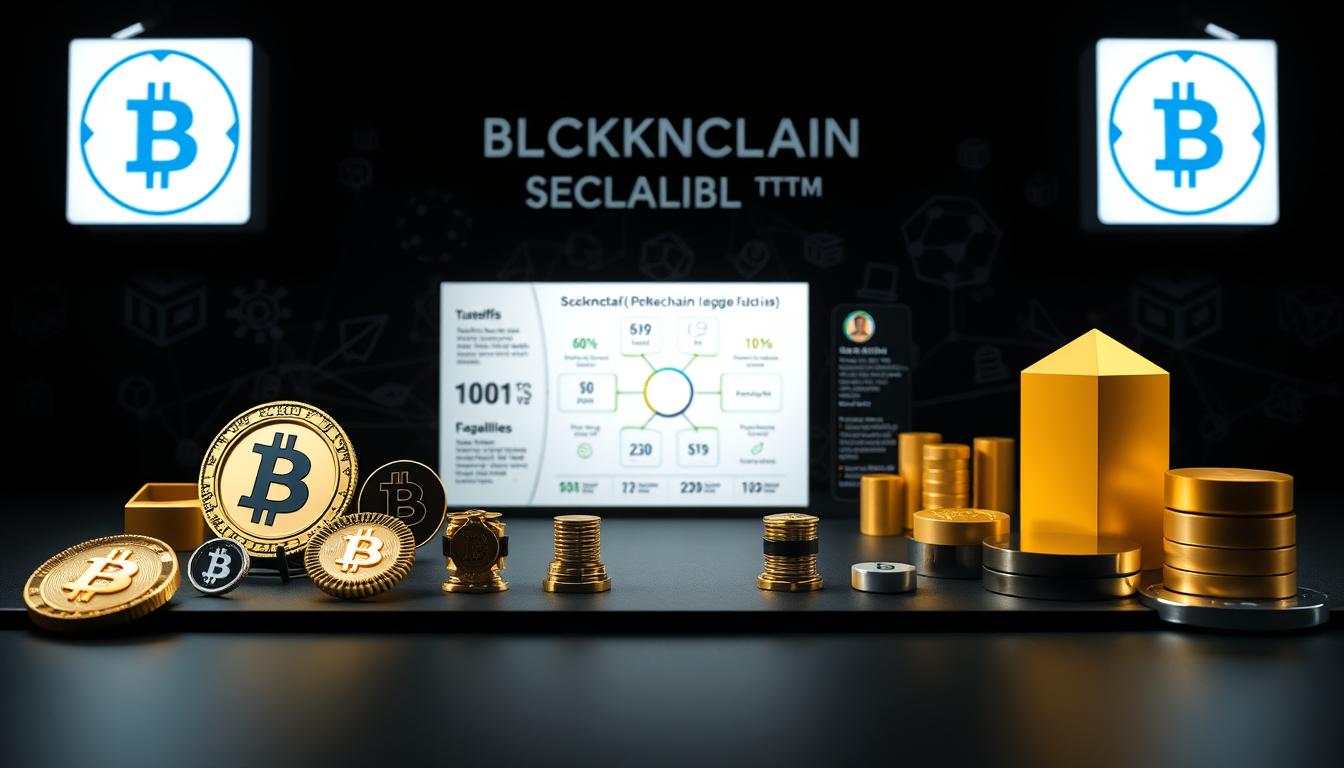Now Reading: How Blockchain Transforms Financial Services
- 01
How Blockchain Transforms Financial Services
How Blockchain Transforms Financial Services

The digital ledger technology reshaping global markets is creating seismic shifts in how institutions manage value. By eliminating intermediaries and enabling peer-to-peer transactions, this innovation offers unprecedented transparency and efficiency. From cross-border payments to automated agreements, its applications are redefining trust in economic systems.
Traditional banking frameworks now face competition from decentralized networks that operate 24/7 without centralized control. Smart contracts, self-executing agreements coded onto chains, reduce paperwork and human error while accelerating processes like loan approvals or insurance claims. These tools empower businesses to streamline operations and cut costs.
Institutional investors increasingly recognize the potential of distributed ledger systems to mitigate fraud and enhance audit trails. Meanwhile, fintech startups leverage these protocols to build inclusive platforms for underbanked populations. As adoption grows, legacy institutions must adapt or risk losing relevance in a digitized economy.
Key Takeaways
- Decentralized networks reduce reliance on third-party intermediaries in transactions
- Smart contracts automate complex agreements with built-in compliance checks
- Real-time settlement capabilities accelerate global payment systems
- Enhanced security protocols minimize fraud risks in asset management
- Traditional banks face pressure to integrate distributed ledger solutions
Understanding Blockchain Fundamentals
Blockchain technology acts as the backbone of modern financial systems, reshaping how institutions handle value exchange. Its architecture combines advanced cryptography with decentralized governance – a formula that eliminates single points of failure while creating unprecedented transparency.
Core Components of Distributed Ledger Technology
Decentralized Network Architecture
Traditional banking systems rely on central databases vulnerable to outages and attacks. Blockchain flips this model by distributing identical transaction records across thousands of nodes. JPMorgan’s Quorum blockchain demonstrates this principle – their permissioned network processes private transactions while maintaining enterprise-grade performance.
This architecture achieves two critical goals:
- Continuous uptime: No single server failure can halt operations
- Tamper resistance: Changing records requires overwhelming network consensus
Cryptographic Security Mechanisms
Every blockchain transaction gets locked with SHA-256 encryption – the same standard protecting classified government data. Financial institutions use Merkle trees to bundle transactions into verifiable blocks. This creates an unbroken security chain where altering one record would invalidate all subsequent entries.
Real-world impact:
- Reduced fraud in cross-border payments
- Instant verification of asset ownership
Consensus Algorithms Explained
Different blockchain networks use unique validation methods tailored to their needs:
| Algorithm | Used By | Transaction Speed |
|---|---|---|
| Proof of Work (PoW) | Bitcoin | 7 TPS |
| Proof of Stake (PoS) | Ethereum 2.0 | 100,000 TPS |
| Byzantine Fault Tolerance (BFT) | Ripple | 1,500 TPS |
Enterprise blockchains often combine elements – Hyperledger Fabric uses modular consensus for flexible financial applications.
Key Characteristics Enabling Financial Innovation
Immutability and Audit Trails
Blockchain’s permanent records solve Wall Street’s reconciliation headaches. Goldman Sachs estimates distributed ledgers could save $12 billion annually in trade settlement costs. Every asset movement gets timestamped and cryptographically sealed – perfect for regulatory audits.
Real-Time Transaction Processing
Traditional ACH transfers take 3 days. Blockchain networks like Stellar settle cross-border payments in 4 seconds. This speed comes from eliminating intermediary banks – funds move directly between digital wallets with automated compliance checks.
Smart Contract Capabilities
These self-executing agreements automate complex financial workflows. AXA’s Fizzy insurance platform uses smart contracts to pay flight delay claims automatically. Key benefits include:
- 24/7 contract enforcement
- Reduced legal disputes
- Programmable escrow services
How Blockchain Revolutionizes Financial Services Through Payment Systems
Modern payment systems face growing demands for speed and affordability. Blockchain technology emerges as a game-changer, offering solutions that outpace traditional banking infrastructure. This section examines how distributed ledger systems reshape domestic and international transactions.
Transforming Traditional Payment Infrastructure
Legacy systems struggle with slow processing times and high fees. Blockchain-powered alternatives demonstrate measurable improvements in efficiency and cost-effectiveness.
SWIFT vs RippleNet Comparison
The SWIFT network processes cross-border payments in 1-5 business days with multiple intermediaries. RippleNet completes transactions in 3-5 seconds using blockchain payment rails. MoneyGram’s integration with RippleNet reduced liquidity costs by 85% while expanding service to 15 new markets.
| Feature | SWIFT | RippleNet |
|---|---|---|
| Transaction Speed | 1-5 days | 3-5 seconds |
| Average Cost | $25-$50 | $0.0002 |
| Currency Conversion | Separate process | Built-in DEX |
Federal Reserve’s FedNow Integration
The FedNow Service enables 24/7 instant payments across U.S. banks. While not blockchain-based, its API architecture allows seamless integration with distributed ledger systems. Early adopters report 92% faster settlement cycles compared to ACH transfers.
Cryptocurrency Payment Solutions
Digital currencies leverage blockchain payment rails to create borderless financial networks. These systems eliminate geographic restrictions while maintaining robust security protocols.
Bitcoin Lightning Network Adoption
The Lightning Network processes 1 million+ transactions daily with near-zero fees. Major platforms like BitPay now support Lightning payments, enabling micropayments as small as $0.01. Starbucks reported 34% faster checkout times during its Miami Bitcoin pilot program.
Stablecoin Implementations: USDC and FDUSD
Circle’s USDC handles $50 billion monthly transactions through Visa’s settlement layer. First Digital’s FDUSD combines dollar pegging with real-time audit trails, achieving full regulatory compliance in 18 jurisdictions. These stablecoins demonstrate how blockchain enables:
- Instant merchant settlements
- Reduced currency volatility
- Automated tax reporting
Smart Contracts Reshaping Financial Agreements
Financial institutions are adopting self-executing code to manage agreements with unprecedented precision. These automated financial contracts eliminate intermediaries while enabling programmable workflows across lending, derivatives, and asset management. Below we analyze how this technology handles intricate transactions and navigates evolving regulatory frameworks.
Automating Complex Transactions
Ethereum’s ERC-20 Standard Applications
The ERC-20 protocol has become the backbone for tokenized assets, powering over 500,000 programmable money contracts. Key use cases include:
- Syndicated loan management via automated payment waterfalls
- Derivative settlements executed through price oracle integrations
- Fractional ownership of real estate assets
Major banks now use ERC-20 tokens to represent traditional securities, reducing settlement times from days to minutes. A recent study shows ERC-20-based systems process $4.7B daily in institutional transactions.
DeFi Lending Protocols: Aave and Compound
Aave’s flash loans and Compound’s algorithmic rates demonstrate automated financial contracts at scale:
| Platform | Unique Feature | TVL (2024) |
|---|---|---|
| Aave | Collateral swapping | $12.3B |
| Compound | Multi-chain support | $8.9B |
Both platforms automatically adjust interest rates based on real-time supply/demand data, serving over 2 million active users.
Legal Implications and Compliance
SEC Regulations on Smart Contract Platforms
The SEC has intensified scrutiny of tokenized securities, issuing 23 enforcement actions in 2023 alone. Key focus areas include:
- Classification of governance tokens as securities
- Liquidity pool operator responsibilities
- Disclosure requirements for automated market makers
KYC/AML Solutions in Decentralized Finance
Leading DeFi compliance solutions combine on-chain analytics with privacy-preserving verification:
- Chainlink’s Proof-of-Reserve audits collateral in real-time
- Elliptic’s transaction monitoring flags high-risk wallets
- ID.me’s zk-SNARKs enable anonymous credential checks
These tools help platforms maintain regulatory alignment while preserving decentralization principles.
Decentralized Finance (DeFi) Ecosystem Growth

With over $100 billion locked in protocols, decentralized finance has become a formidable challenger to traditional banking systems. This blockchain-powered ecosystem eliminates intermediaries through automated protocols, creating financial services accessible to anyone with an internet connection. Two parallel developments drive this revolution: disruptive DeFi platforms redefining banking fundamentals and institutional players cautiously embracing crypto innovations.
Major DeFi Platforms Transforming Banking
Pioneering decentralized applications demonstrate blockchain’s capacity to rebuild financial infrastructure from the ground up. These platforms combine smart contracts with economic incentives to create self-sustaining ecosystems.
Uniswap’s Decentralized Exchange Model
Uniswap V3 introduced concentrated liquidity, allowing providers to set custom price ranges for their assets. This upgrade:
- Increased capital efficiency by 4,000x compared to V2
- Enabled institutional-grade trading strategies on-chain
- Reduced slippage for large transactions by 90%
The protocol’s automated market maker design processes $2 billion daily, rivaling traditional stock exchanges without requiring user identification.
MakerDAO’s Collateralized Lending System
MakerDAO’s DAI stablecoin now supports real-world assets as collateral, including:
- U.S. Treasury bonds ($1.2 billion allocated)
- Commercial real estate mortgages
- Blue-chip corporate debt
This shift bridges decentralized finance with traditional markets, offering 3-5% APY savings accounts that outperform most U.S. bank offerings.
Institutional Adoption Trends
Wall Street’s cautious embrace signals DeFi’s growing legitimacy. Major financial institutions now deploy blockchain solutions alongside traditional systems.
BlackRock’s Blockchain ETF Offerings
The asset manager’s BUIDL fund holds $500 million in blockchain-related assets, including:
- Tokenized U.S. Treasuries
- Bitcoin mining stocks
- Smart contract platform tokens
This product gives institutional investors regulated exposure to crypto markets through familiar investment vehicles.
JPMorgan’s Onyx Digital Assets Platform
Onyx processes $1 billion daily in blockchain-based repo transactions, featuring:
- Instant settlement instead of 2-day delays
- Automated collateral management
- 24/7 market operations
The platform reduces counterparty risk while maintaining compliance with U.S. banking regulations.
Blockchain in Capital Markets Innovation
The integration of blockchain into capital markets is revolutionizing how traditional assets are managed and traded globally. This shift enables faster transactions, reduced costs, and increased accessibility to previously illiquid markets. Financial institutions now leverage distributed ledger technology to address longstanding inefficiencies in securities lifecycle management.
Tokenization of Traditional Assets
Asset tokenization converts physical and financial assets into digital tokens, enabling fractional ownership and 24/7 trading. This innovation democratizes access to high-value investments while improving market liquidity.
Real Estate Tokenization Platforms: RealT and Propy
RealT pioneers fractional property ownership by tokenizing U.S. real estate assets. Investors can purchase shares in rental properties for as little as $50, receiving proportional rental income through smart contracts. Propy streamlines cross-border transactions using blockchain-based title registries, reducing closing times from weeks to days.
| Platform | Focus | Minimum Investment | Key Feature |
|---|---|---|---|
| RealT | Residential Rentals | $50 | Automated Dividend Payments |
| Propy | Global Transactions | $1,000 | NFT Property Deeds |
Security Token Offerings (STOs) Regulation
The SEC’s Regulation D exemptions allow STOs to raise capital without full registration, provided they target accredited investors. Key compliance requirements include:
- 12-month holding periods for tokens
- Anti-money laundering (AML) checks
- Investor accreditation verification
Recent analysis shows 78% of STO issuers now implement automated compliance tools, reducing regulatory risks by 40% compared to traditional offerings.
Stock Settlement Improvements
Blockchain enables T+0 settlement, eliminating the traditional 2-day clearance period. This reduces counterparty risk and frees up $120 billion in trapped capital annually across global markets.
DTCC’s Project Whitney Progress
The Depository Trust & Clearing Corporation (DTCC) successfully tested blockchain prototypes for corporate action processing. Their system achieved:
- 85% reduction in reconciliation errors
- 60% faster dividend distributions
- Real-time audit trails for regulators
Nasdaq’s Linq Blockchain Platform
Nasdaq’s platform processed over 1 million proxy votes in 2023 using blockchain-based identity verification. Key features include:
| Feature | Traditional System | Linq Platform |
|---|---|---|
| Vote Processing Time | 5-7 Days | 2 Hours |
| Transaction Cost | $2.50 per vote | $0.15 per vote |
| Audit Capability | Manual Reconciliation | Immutable Records |
Enhancing Trade Finance Operations
Global trade finance faces mounting pressure to modernize outdated systems. Blockchain emerges as a transformative force, streamlining processes while addressing systemic inefficiencies. This technology redefines how businesses manage cross-border transactions through automation and enhanced transparency.

Documentation and Process Automation
Marco Polo Network Implementations
The Marco Polo Network demonstrates blockchain’s capacity to slash processing times in documentary trade. HSBC executed Asia’s first blockchain-based letter of credit transaction through this platform, reducing typical 5-10 day processes to 24 hours. Key features include:
- Real-time invoice matching across 25+ banks
- Automated compliance checks using smart contracts
- Integrated trade payment commitments
This network eliminates paper-based bottlenecks while maintaining strict regulatory adherence. Corporate users report 40% reductions in administrative costs and 65% faster settlement cycles.
we.trade’s Supply Chain Solutions
BMW’s automotive parts tracking through we.trade showcases blockchain’s supply chain finance potential. The platform enables:
| Feature | Traditional Process | Blockchain Solution |
|---|---|---|
| Order Verification | 7-10 business days | 2 hours |
| Payment Guarantees | Manual bank approvals | Smart contract triggers |
| Multi-party Coordination | Email/Fax chains | Shared digital ledger |
Suppliers gain immediate liquidity through automated financing options tied to verified shipment milestones. This approach has enabled BMW to optimize working capital across 12 European manufacturing hubs.
Risk Mitigation Strategies
Letter of Credit Automation
Blockchain letters of credit remove counterparty risks through cryptographic verification. Standard Chartered’s recent implementation features:
- Biometric participant authentication
- Automatic document expiry alerts
- Fraud pattern detection algorithms
These systems reduce discrepancies by 78% compared to manual LC processing. Banks can now process $50M+ transactions with complete audit trails in under 4 hours.
Fraud Prevention Through Distributed Ledgers
Shared visibility across blockchain networks prevents duplicate financing scams. Key protections include:
- Immutable records of asset ownership
- Real-time collateral tracking
- Automated fraud scoring models
HSBC’s blockchain trade platform intercepted $250M in potential duplicate financing attempts during its first year of operation. The system flags suspicious patterns before fund disbursement, protecting all transaction participants.
Identity Verification and KYC Processes
Blockchain technology is redefining how financial institutions handle identity verification by shifting control to users while meeting strict regulatory standards. Unlike traditional systems reliant on centralized databases, decentralized approaches reduce fraud risks and operational costs through cryptographically secure methods.
Self-Sovereign Identity Solutions
Self-sovereign identity (SSI) systems allow individuals to own and share verified credentials without intermediaries. These frameworks use blockchain to create tamper-proof records, streamlining Know Your Customer (KYC) workflows.
Microsoft’s ION Decentralized Identity Network
Built on Bitcoin’s blockchain, Microsoft’s ION network enables decentralized identity management through Decentralized Identifiers (DIDs). Users control access to personal data like government IDs or bank details, sharing only necessary information with institutions. Major banks now test ION to simplify customer onboarding while maintaining GDPR compliance.
Circle’s Verite Framework Applications
Circle’s Verite standard provides portable credentials for DeFi platforms and crypto exchanges. Its open-source tools let users prove accreditation status or residency without exposing sensitive data. Gemini and Uniswap use Verite to automate compliance checks, reducing manual review time by 65%.
| Feature | Microsoft ION | Circle Verite |
|---|---|---|
| Blockchain Base | Bitcoin | Multi-chain |
| Key Technology | Decentralized Identifiers | Verifiable Credentials |
| Primary Use | Enterprise KYC | DeFi Compliance |
| Regulatory Alignment | GDPR, CCPA | FATF Travel Rule |
Regulatory Compliance Improvements
Blockchain’s transparency helps institutions meet evolving crypto compliance solutions requirements. Real-time audit trails and automated reporting address regulators’ concerns about illicit activities.
FATF Travel Rule Implementations
The Financial Action Task Force’s Travel Rule compliance mandates sharing sender/receiver data for crypto transfers over $3,000. Blockchain analytics firms like Chainalysis and Elliptic provide tools to securely transmit required information between Virtual Asset Service Providers (VASPs).
Chainalysis Compliance Tools Adoption
Over 30 governments use Chainalysis’ blockchain forensic software to monitor transactions. Its Reactor platform maps wallet addresses to real-world entities, helping institutions flag high-risk activities. OFAC employs these tools to enforce sanctions against non-compliant crypto businesses.
Insurance Industry Transformation
Blockchain is rewriting the rules of insurance by tackling two critical challenges: slow claims processing and systemic fraud. Through parametric insurance smart contracts and decentralized verification systems, insurers now resolve claims in minutes instead of weeks while reducing fraudulent payouts by up to 40%. This shift is particularly evident in niche markets like flight delay coverage and large-scale initiatives targeting claim history transparency.
Claims Processing Automation
Traditional insurance workflows drown in paperwork and manual checks, but blockchain introduces self-executing solutions. By linking policies to real-world data triggers, companies automate payouts while maintaining regulatory compliance.
Etherisc’s Flight Delay Insurance
Etherisc partners with airlines to offer flight delay coverage powered by blockchain claims processing. Their system connects flight APIs to smart contracts that automatically release payments when delays exceed two hours. Passengers receive compensation in their wallets before baggage claim, eliminating claim forms and adjuster reviews. This model has processed over 12,000 instant payouts since 2022.
AXA’s Fizzy Parametric Insurance
AXA’s Fizzy platform takes automation further with weather-indexed parametric policies. A New York-to-London flight policy might activate if volcanic ash clouds cause cancellations, verified through satellite data feeds. The smart contract holds premiums in escrow until predefined conditions occur, ensuring 98% of valid claims settle within 90 minutes.
Fraud Detection Enhancements
Insurers lose $40 billion annually to fraudulent claims, but blockchain’s immutable audit trails are reversing this trend. Distributed ledgers create unified records of claims history accessible across organizations.
Allianz’s Blockchain Claim History Database
Allianz built a cross-industry database tracking 14 million claims using blockchain-powered insurance models. When a user files a claim, participating insurers instantly verify past incidents and policy overlaps. This system flagged 23,000 duplicate claims in its first year, saving $180 million in wrongful payouts.
RiskStream Collaborative Initiatives
The RiskStream alliance, featuring 45 major insurers, uses blockchain for real-time insurance fraud prevention. Their system analyzes claim patterns across members, identifying suspicious providers who bill multiple companies for the same auto repair. Early pilots reduced investigation time for complex fraud cases from 42 days to 72 hours.
Central Bank Digital Currencies (CBDCs)
Central banks worldwide are racing to develop digital currencies that blend modern technology with monetary policy needs. These initiatives aim to enhance payment efficiency while addressing critical challenges like digital currency privacy and financial stability.
Federal Reserve’s Digital Dollar Project
The U.S. Federal Reserve’s exploratory work on a wholesale CBDC focuses on interbank transactions rather than consumer use. This approach prioritizes financial system modernization without disrupting existing retail banking structures.
Project Hamilton Technical Framework
Developed through a Boston Fed-MIT partnership, Project Hamilton tests a two-tiered system where the central bank issues currency through regulated intermediaries. The framework uses distributed ledger technology to process 1.7 million transactions per second – far exceeding Visa’s capacity. Key features include:
- Offline transaction capabilities
- Atomic settlement finality
- Interoperability with legacy systems
Privacy vs Control Considerations
Policymakers face a tightrope walk between user anonymity and regulatory oversight. While zero-knowledge proofs could enable transaction verification without revealing personal data, concerns persist about programmable money enabling excessive government control. Current proposals suggest:
- Tiered privacy levels based on transaction size
- Time-limited data access for law enforcement
- Opt-in transparency for tax compliance
Global CBDC Implementations
Countries are adopting distinct strategies reflecting their financial systems and governance philosophies. A comparative analysis reveals fundamental architectural differences:
| Country | Model | Key Feature | Adoption Stage |
|---|---|---|---|
| China | Centralized | State-controlled wallets | National rollout |
| Eurozone | Hybrid | Bank-mediated distribution | Pilot testing |
| USA | Wholesale | Interbank focus | Research phase |
China’s Digital Yuan Expansion
China’s e-CNY leads global CBDC development with 260 million wallets created by 2023. The People’s Bank tightly controls:
- Transaction limits (¥5,000 daily cap)
- Geographic availability (23 pilot regions)
- Cross-border testing with Hong Kong
ECB’s Digital Euro Pilot Programs
The European Central Bank’s prototype emphasizes privacy through:
- Pseudonymous small transactions
- Offline payment functionality
- Commercial bank intermediation
Phase three testing involves 12 major EU banks simulating high-volume transaction scenarios through 2024.
Blockchain in Accounting and Auditing
Blockchain technology is redefining how businesses manage financial data, offering unprecedented accuracy and transparency. By automating record-keeping and creating immutable audit trails, distributed ledgers eliminate manual errors while accelerating reporting cycles. This shift is particularly transformative for accounting teams and auditors who rely on real-time data integrity.

Real-Time Financial Reporting
Modern blockchain solutions enable companies to track financial transactions instantly across departments. This real-time financial reporting capability reduces reconciliation delays from weeks to minutes, a critical advantage highlighted in our analysis of blockchain’s banking applications.
Deloitte’s PermaRecord Solutions
Deloitte’s PermaRecord leverages triple-entry accounting principles to create tamper-proof transaction records. The system automatically cross-verifies entries between buyers, sellers, and auditors, cutting monthly closing processes by 40%. Financial teams gain live access to:
- Automated balance sheet updates
- Multi-party transaction verification
- Smart contract-triggered journal entries
EY’s OpsChain Implementations
EY’s blockchain team developed OpsChain to streamline intercompany accounting. The platform’s Baseline Protocol synchronizes financial data across 14 ERP systems simultaneously, resolving 92% of ledger mismatches during pilot tests. Key features include:
- Automated tax compliance checks
- Real-time currency conversion auditing
- AI-powered anomaly detection
Audit Trail Improvements
Blockchain’s unalterable transaction history creates audit trails that withstand regulatory scrutiny. PwC research shows these systems reduce evidence collection time by 67% during financial audits.
PwC’s Halo Audit Technology
PwC’s Halo platform uses blockchain to monitor smart contracts across supply chains. The tool automatically flags discrepancies in:
| Risk Area | Detection Method | Resolution Time |
|---|---|---|
| Inventory Valuation | IoT sensor cross-check | 2.1 hours |
| Revenue Recognition | Smart contract analysis | 15 minutes |
| Tax Compliance | Regulatory API integration | Real-time |
Continuous Auditing Capabilities
Modern systems enable 24/7 transaction monitoring through blockchain-powered dashboards. KPMG’s recent implementation reduced quarterly audit preparation from 3 weeks to 4 days by:
- Automating evidence preservation
- Streamlining auditor-client collaboration
- Applying machine learning to risk patterns
Supply Chain Finance Innovations
Blockchain technology is rewriting the rules of supply chain finance by creating transparent, real-time ecosystems for businesses. This shift enables companies to unlock working capital and reduce operational friction through decentralized verification systems. Two critical areas driving this transformation include inventory management modernization and payment process optimization.
Inventory Financing Solutions
IBM Food Trust Applications
Walmart’s adoption of IBM Food Trust demonstrates blockchain’s power in inventory financing. The system tracks produce from farm to store using distributed ledger technology, cutting verification times from 7 days to 2.2 seconds. This real-time visibility allows suppliers to:
- Access faster invoice approvals
- Secure loans against verified inventory
- Reduce spoilage-related financial losses
Retail partners using the platform reported 35% faster financing approvals and 18% lower insurance costs. The blockchain-based audit trail helps lenders assess risk more accurately, creating new opportunities for inventory financing in perishable goods sectors.
TradeLens Platform Implementations
Maersk’s TradeLens tackles document handling in global shipping, processing 30 million container events monthly. By digitizing bills of lading, the platform:
- Reduces cargo release times from 10 days to 1 hour
- Automates customs clearance processes
- Provides instant proof of shipment for lenders
This trade document automation enables exporters to secure financing 60% faster than traditional methods. Major U.S. ports using TradeLens have seen 45% fewer document-related delays, significantly improving cash flow for small freight forwarders.
Supplier Payment Automation
HSBC’s Serai Platform Features
HSBC’s Serai network streamlines cross-border payments for 28,000+ suppliers across 20 countries. The blockchain solution automatically matches purchase orders with shipping documents, triggering instant payments upon delivery confirmation. Key benefits include:
- 72-hour reduction in payment processing times
- Dynamic discounting based on real-time risk scores
- Multi-currency settlement without intermediary banks
Early adopters achieved 29% lower transaction costs and 94% payment accuracy. The platform’s blockchain supply chain finance capabilities help suppliers maintain better cash flow visibility throughout production cycles.
Komgo’s Commodity Trade Solutions
Komgo revolutionizes energy sector financing by connecting 85+ banks with commodity traders on a single blockchain network. Its automated letter-of-credit system processes $12 billion in transactions annually, featuring:
- Smart contract-based compliance checks
- Real-time cargo tracking integration
- Automated discrepancy resolution
Users complete transactions 75% faster than through conventional banking channels. The platform’s success in trade document automation has expanded to agricultural commodities, demonstrating blockchain’s scalability across supply chain verticals.
Blockchain for Financial Inclusion
Blockchain technology is breaking down barriers to financial access, offering secure and affordable solutions to unbanked populations worldwide. By eliminating intermediaries and reducing costs, decentralized systems empower individuals in emerging markets to participate in global economic activities. This section explores how blockchain platforms are reshaping banking and lending for underserved communities.
Emerging Market Banking Solutions
Innovative blockchain projects are addressing the challenges of traditional banking infrastructure in developing regions. These platforms prioritize accessibility through mobile technology and low-cost transactions, creating pathways for economic growth.
Stellar’s Cross-Border Remittance Networks
Stellar Lumens (XLM) has transformed international money transfers through partnerships with major financial institutions like MoneyGram. The network enables near-instant settlements at 60-80% lower costs than conventional services. Migrant workers in the US can now send funds to families in countries like the Philippines or Nigeria within seconds.
Key features driving adoption include:
- Interoperability with local mobile money platforms
- Atomic swap technology for currency conversions
- Built-in compliance tools for regulatory alignment
Celo’s Mobile-First Financial Platform
Celo’s cUSD stablecoin brings dollar-pegged transactions to smartphone users without bank accounts. In Kenya and Guatemala, farmers use the platform to receive payments, access credit, and insure crops through simple USSD codes. The ecosystem supports:
- Frictionless peer-to-peer transfers
- Savings accounts with algorithmic interest rates
- Integration with local merchant networks
Microfinance and Peer-to-Peer Lending
Decentralized finance models are reinventing community-based lending through transparent record-keeping and risk-sharing mechanisms. These systems enable small-scale borrowers to build credit histories while offering investors measurable social impact.
Kiva’s Blockchain Loan Tracking
The nonprofit Kiva uses distributed ledgers to track microloans for refugee entrepreneurs in Jordan and Uganda. Lenders worldwide can verify how funds are used in real-time, with repayment rates exceeding 96%. The system helps displaced populations:
- Access startup capital without collateral
- Establish portable digital identities
- Connect with global investor networks
Algorand’s East Africa Initiatives
Algorand partners with the African Development Bank to streamline agricultural financing across Rwanda and Tanzania. Smart contracts automate loan disbursements when farmers meet predefined harvest targets. The platform’s carbon-neutral blockchain supports:
- Weather-indexed crop insurance
- Equipment leasing through tokenized assets
- Real-time repayment tracking
Cybersecurity and Fraud Prevention
Blockchain technology introduces groundbreaking security protocols to combat evolving digital threats in finance. As cyberattacks grow more sophisticated, institutions leverage advanced cryptographic methods and real-time monitoring to protect assets and user data.
Enhanced Data Protection
Quantum-resistant cryptography
Financial institutions are adopting quantum-safe cryptography to safeguard blockchain networks against future quantum computing threats. Lattice-based algorithms, which rely on complex mathematical structures, are emerging as a leading solution. These systems remain secure even when facing quantum-powered decryption attempts.
Key benefits include:
- Long-term protection for sensitive financial records
- Compatibility with existing blockchain infrastructure
- Regulatory compliance for data retention policies
Multi-party computation techniques
MPC wallets revolutionize private key management by splitting cryptographic secrets across multiple parties. This approach eliminates single points of failure while maintaining transaction authorization capabilities. Financial platforms using MPC have reported:
- 60% reduction in wallet compromise incidents
- Faster transaction approvals through distributed verification
- Improved compliance with data privacy regulations
Transaction Monitoring Systems
Elliptic’s blockchain analytics
Elliptic provides crypto fraud detection tools that map blockchain transactions to real-world entities. Their system flags suspicious patterns using machine learning and global watchlists. Major exchanges using Elliptic have achieved:
| Metric | Improvement | Timeframe |
|---|---|---|
| Illicit transaction detection | 92% accuracy | 2021-2023 |
| False positive reduction | 41% decrease | 2022-2024 |
TRM Labs’ risk assessment tools
TRM Labs offers compliance solutions that analyze over 50 risk indicators across blockchain networks. Their platform helps institutions:
- Identify sanctioned wallet addresses in real-time
- Track cross-chain money laundering patterns
- Generate audit-ready compliance reports
Recent deployments show 78% faster investigation times for suspected fraud cases compared to traditional methods.
The Future of Blockchain in Finance
Blockchain finance trends point to a future where distributed ledger technology merges with artificial intelligence and IoT systems. JPMorgan’s Onyx Digital Assets network already combines blockchain with AI for real-time risk analysis, showing how these integrations could redefine financial decision-making. Web3 financial services built on decentralized protocols may reshape how institutions interact with digital assets and customer data.
Interoperable ledgers like those proposed in the Bank for International Settlements’ unified architecture project aim to connect central banks, commercial banks, and payment systems. This approach could streamline cross-border transactions while maintaining regulatory oversight. Major platforms like Uniswap and Compound are pushing institutional DeFi adoption through compliant liquidity pools and governance frameworks.
Regulatory developments such as the EU’s Markets in Crypto-Assets (MiCA) regulation suggest growing global coordination for crypto supervision. These frameworks aim to balance innovation with consumer protections as blockchain expands into mainstream banking. Companies like Ripple and SWIFT are testing solutions that bridge traditional finance with decentralized networks.
The next phase of blockchain evolution will likely focus on creating seamless connections between smart contracts, IoT devices, and legacy financial infrastructure. As central banks pilot digital currencies and corporations adopt tokenized assets, the financial landscape appears poised for deeper transformation. Stakeholders must stay informed about these shifts to navigate emerging opportunities in Web3 financial services effectively.














